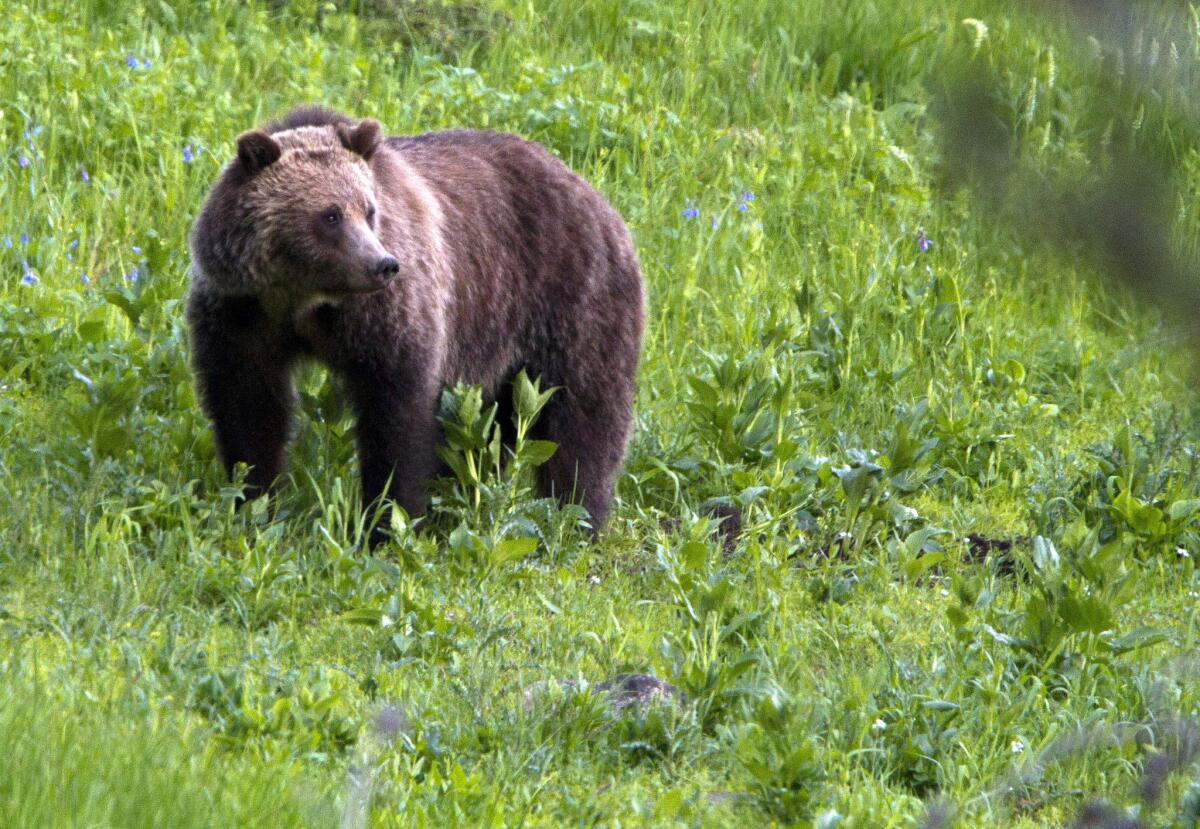Grizzly bears are rebounding in Yellowstone. Should hunting be allowed to keep numbers in check?

A decade after federal wildlife officials tried and failed to remove protections for grizzly bears that live in and near Yellowstone National Park, they are trying again, this time declaring that bear recovery efforts have been a “historic success.”
Pointing to estimates that the Yellowstone population has increased from as few as 136 bears in 1975, the year they were listed as threatened, to as many as 700 today, the U.S. Fish and Wildlife Service this week proposed removing federal protections in favor of an oversight plan that would be enforced by state governments — one that would allow hunting bears that roam outside the park.
The agency said the bear’s range in what is known as the Greater Yellowstone Ecosystem, an area that includes parts of Wyoming, Montana and Idaho, had more than doubled during the last four decades. At the same time, it said the number of bears had remained basically the same since 2002. The agency said that stable population was a sign that “the Yellowstone ecosystem is at or near its carrying capacity for the bears.”
I guess there’s going to be a question of how comfortable the American public is with the killing off of more than 100 grizzly bears.
— Tim Preso, a lawyer with Earthjustice
Environmental groups had long anticipated the decision, announced Thursday, and they responded much as they did nearly a decade ago, saying the move would put bears at risk. Some suggested they could take the fight to court, just as they did before.
In 2009, two years after the government attempted to remove protections, a federal judge in Montana restored them, saying that new safeguards put in place were not enforceable and that climate change posed risks to one of the bears’ most important foods — seeds from whitebark pine trees that were dying at alarming rates. The 2009 ruling was upheld on appeal in 2011.
Join the conversation on Facebook >>
On Thursday, Tim Preso, a lawyer with the environmental law firm Earthjustice, which led the earlier challenge, said in an interview that the firm was still reviewing the new plan but that it appeared to raise many of the same questions that existed a decade ago. Among them: whether state governments would truly meet new requirements that they protect the bears and whether the plan adequately considers how climate change is affecting the animals.
Though more than 700 bears are believed to exist now, the plan would hope to keep the population at about 674, which the government said was the average from 2002 to 2014. If the number dropped to 600, “discretionary mortality” — that means hunting — would not be allowed.
Preso noted that although states have agreed to enforce the plan they have not yet passed binding regulations to do so.
“All three states have to do things to do their part, and we don’t yet know what that’s going to look like,” he said. “As of right now, it’s just a framework without the details.”
Preso said one reason the bears have expanded their range is because the whitebark pine continues to decline, forcing animals to travel farther to find food. He said bears are adapting in some cases by eating more meat, whether wild game or livestock. That creates conflicts with hunters and ranchers and often leads to bears being killed by humans, ostensibly in self-defense or by wildlife officials.
If they are delisted, grizzlies inside Yellowstone National Park could not be legally hunted. But they would not have to wander far, perhaps for as little as 15 minutes from where park visitors can see them in the wild, before they enter legal hunting areas.
“I guess there’s going to be a question of how comfortable the American public is with the killing off of more than 100 grizzly bears,” Preso said.
Political leaders in the three-state area have pressed the government to delist the bears, pointing to the 2007 decision as evidence that they recovered long ago.
“Previous efforts to de-list the bear were held hostage by litigation,” Sen. Michael B. Enzi (R-Wyo.) said in a written statement. “This is no way to manage wildlife. As grizzly bear populations increase beyond capacity in Wyoming, so does the danger posed to livestock, property and humans. That is why it is so important that we turn over management of the species to state authorities.”
The Yellowstone area is home to as many as half of the estimated 1,400 to 1,700 grizzlies believed to exist in the Lower 48 states. The proposed delisting would not apply to bear populations in other areas of the West that are under federal protection.
“All other grizzly bears in the Lower 48 states remain listed,” the Fish and Wildlife Service said.
The plan will go through a formal period of public review and could become final later this year.
For news on the environment follow @yardleyLAT on Twitter.
ALSO
Hikers lament the end of fun at Runyon Canyon Park
In the Everglades, birds nest near alligators for safety. But what’s in it for the gators?
Did cities collude with fundamentalist Mormon sect to persecute nonbelievers? A jury will decide
More to Read
Start your day right
Sign up for Essential California for news, features and recommendations from the L.A. Times and beyond in your inbox six days a week.
You may occasionally receive promotional content from the Los Angeles Times.







